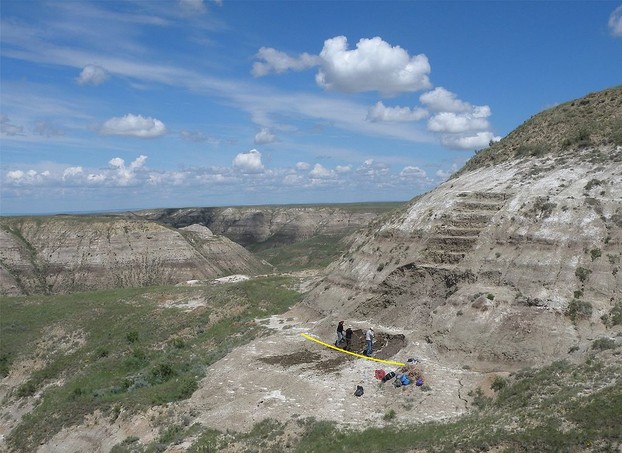AFP. 8 July 2015. “Dinosaures: Un nouveau type de tricératops découvert.” 20 Minutes. 20minutes.fr > sciences.
- Available at: http://www.20minutes.fr/sciences/1648715-20150708-dinosaures-nouveau-type-triceratops-decouvert#xtor=RSS-176
AFP. 8 July 2015. “Legendary Dinosaur Family Gets Curly Horned New Member.” Yahoo News. uk.news.yahoo.com > science.
- Available at: https://uk.news.yahoo.com/legendary-dinosaur-family-gets-curly-horned-member-193433496.html?.tsrc=yahoo#MFuumKT
Bora, Kukil. 9 July 2015. “Wendiceratops: Scientists Discover New Species of Horned Dinosaur That Lived 79 Million Years Ago.” International Business Times. ibtimes.com > technology > science.
- Available at: http://www.ibtimes.com/wendiceratops-scientists-discover-new-species-horned-dinosaur-lived-79-million-years-2001038
Boyle, Alan. 8 July 2015. “Wendiceratops: Horned Dinosaur Fossil Adds Hooks to Evolutionary Tale.” nbcnews.com > science > weird science.
- Available at http://www.nbcnews.com/science/weird-science/wendiceratops-horned-dinosaur-fossil-adds-evolutionary-hook-n388786
Brumfield, Ben. 9 July 2015. “New Dinosaur Species: Wendiceratops’ Nose Horn is a Missing Link in Evolution. Cable News Network. Turner Broadcasting System, Inc. cnn.com > americas.
- Available at: http://www.cnn.com/2015/07/09/americas/new-dinosaur-wendiceratops-alberta-canada/index.html
Chung, Emily. 8 July 2015. “New ‘Wendiceratops’ Named for Legendary Alberta Dinosaur Hunter Wendy Sloboda.” CBC/Radio Canada. cbc.ca/news > technology & science.
- Available at: http://www.cbc.ca/news/technology/new-wendiceratops-named-for-legendary-alberta-dinosaur-hunter-wendy-sloboda-1.3143196
Cleveland Museum of Natural History. 8 July 2015.”New Horned Dinosaur Reveals Evolution of Nose Horn in Triceratops Family.” Phys.org > news > other sciences > archaeology & fossils.
- Available at: http://phys.org/news/2015-07-horned-dinosaur-reveals-evolution-nose.html
Cleveland Museum of Natural History. 8 July 2015. “Wendiceratops pinhornensis: Curator Discovers New Horned Dinosaur Species.” cmnh.org.
- Available at: https://www.cmnh.org/wendiceratops
Evans, David C; and Ryan, Michael J. “Cranial Anatomy of Wendiceratops pinhornensis gen. et sp. nov., A Centrosaurine Ceratopsid from the Oldman Formation (Campanian), Alberta, Canada, and the Evolution of Ceratopsid Nasal Ornamentation.” PLOS ONE dx.plos.org/10.1371/journal.pone.0130007
- Available at: http://journals.plos.org/plosone/article?id=10.1371/journal.pone.0130007
Harris-Lovett, Sasha. “Meet Wendiceratops, a Horned Dinosaur Unlike Any Other.” Los Angeles Times. latimes.com > science.
- Available at: http://www.latimes.com/science/la-sci-sn-new-dinosaur-wendiceratops-20150708-story.html
Liberman, Mark. 9 July 2015. “Wendicertatops.” Language Log. ldc/upenn.edu > the language of science.
- Available at: http://languagelog.ldc.upenn.edu/nll/?p=19923
Moser, Cassidee. 9 July 2015. Paleontologists Discover Triceratops Relative the Wendicertaops.” Ziff Davis, LLC. ign.com/articles.
- Available at: http://www.ign.com/articles/2015/07/09/paleontologists-discover-triceratops-relative-the-wendiceratops
Newcomb, Alyssa. 9 July 2015. “Newly-Discovered Wendiceratops Dinosaur Had Crown of Horns.” ABC News Internet Ventures. abcnews.go.com > technology.
- Available at: http://abcnews.go.com/Technology/newly-discovered-wendiceratops-dinosaur-crown-horns/story?id=32324572
Pant, Shontee. 9 July 2015. “Why Is This New, Curly-horned Dinosaur Named Wendy?” The Christian Science Monitor. csmonitor.com > science.
- Available at: http://www.csmonitor.com/Science/2015/0709/Why-is-this-new-curly-horned-dinosaur-named-Wendy
Pelley, Lauren. 8 July 2015. "New Dinosaur Named After Top Canadian Fossil Hunter." Toronto Star Newspapers Ltd. thestar.com > News / GTA.
- Available at: http://www.thestar.com/news/gta/2015/07/08/new-dinosaur-named-after-top-canadian-fossil-hunter.html
Ryan, Michael J., Brenda J Chinnery-Allgeier, and David A Eberth, eds. 2010. New Perspectives on Horned Dinosaurs: The Royal Tyrrell Museum Ceratopsian Symposium. Bloomington IN: Indiana University Press.














 Are Hawaiian Huakai Po Nightmarchers Avenging Halloween Thursday?on 10/02/2024
Are Hawaiian Huakai Po Nightmarchers Avenging Halloween Thursday?on 10/02/2024
 Mailing Addresses for 2023 Form 4868 Extending 1040 and 1040SR April 15, 2024, Due Dateon 04/15/2024
Mailing Addresses for 2023 Form 4868 Extending 1040 and 1040SR April 15, 2024, Due Dateon 04/15/2024
 Mailing Addresses for 2023 Forms 1040 and 1040SR Filed in 2024on 04/15/2024
Mailing Addresses for 2023 Forms 1040 and 1040SR Filed in 2024on 04/15/2024
 Mailing Addresses for 2022 Form 4868 Extending 1040 and 1040SR April 18, 2023, Due Dateon 04/13/2023
Mailing Addresses for 2022 Form 4868 Extending 1040 and 1040SR April 18, 2023, Due Dateon 04/13/2023



Comments
Country and world gardens and menageries appeal to me as educationally entertaining and entertainingly educational.
Canadian, Canadian-Unitedstatesian border and Unitedstatesian ancient wildlife are sufficiently acquaintable for us to aspire to Canadian and Unitedstatesian ancient-life country gardens.
Cannot the above be anything but a win-win situation for all ages?
The computer crashed before I could commence another component of my comment in the box immediately below.
Plaza Huincul is an elucidating place where the museum includes interesting information about the desert area's world-largest fossils of such dinosaurs as Argentinosaurus, Giganotosaurus and Mapusaurus genera.
So Plaza Huincul is quite a treat for those of us whom Wendy Sloboda's muddy-footed Barrosopus slobodai and world-biggest dinosaur fossils intrigue, isn't it?
Wendy Sloboda accounts for another one of my favoritest dinosaurs, the muddy foot Barrosopus slobodai, from 2003 in the South American country of Argentina’s Plaza Huincul.
Who else is interested in what else America south of the Northern Hemisphere inters?
CruiseReady, It's nice that such an amazing animal honors an amazing woman who has done so much for fossil retrieval and preservation. But it's definitely a look that stands out in a crowd, even with such colleagues as duck-billed dinosaurs and tyrannosaurs!
What an amazing creature that must have been!
happynutritionist, It indeed is truly impressive how many fine images are available because of the generous sharing and meticulous attention of so many competent photographers. It's because of such kindness that landscape pictures are available, and I love your mentioning the assist they give to imagining them with such ancient perambulators as Wendy's horned dinosaurs!
frankbeswick, Thank you for liking this series. Dinosaurs indeed are such great learning fun that they're guaranteed to get children motivated to do homework, pay attention in class, and -- as you suggest -- produce projects for class or science fairs. Everyone becomes a discoverer and explorer -- except in the case of some really scary movies ;-[ -- when it comes to dinosaurs.
I do love the artwork on the page, yes, you are right, the illustrators are so talented. I also appreciate looking out on the vast empty landscape in the photo, imagining what it must have been like to see this dinosaur walking about.
This is a great series on dinosaurs, and it would be so useful to children doing projects at school.